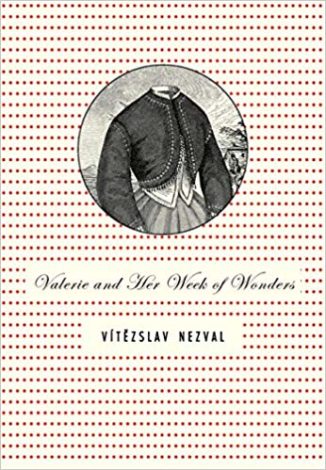 By VITEZSLAV NEZVAL (Twisted Spoon Press; 1945/2005)
By VITEZSLAV NEZVAL (Twisted Spoon Press; 1945/2005)
A real curiosity: a surrealist novel masquerading as a gothic thriller that never entirely satisfies as either. Rather, it’s a rare book that exists in its own indefinable category.
I know VALERIE AND HER WEEK OF WONDERS best in its 1970 film incarnation by director Jaromil Jires, which has in recent years gained an unexpected popularity. The appearance of this 1945 Czech novel in a 2005 English translation is a further manifestation of the newfound VALERIE mania that includes Facets’ 2004 DVD release of the film and the Finders Keepers soundtrack CD two years later.
Yet the film, it turns out, is a totally different animal from the book. While it’s a largely faithful adaptation, Jaromil Jires’ lush, poetic atmosphere is directly opposed to that of the novel, which is much darker in its approach.
Jaromil Jires’ lush, poetic atmosphere is directly opposed to that of the novel, which is much darker in its approach.
It tells the story of Valerie, a 17-year-old girl undergoing a sexual initiation in an undefined dreamlike setting. The incident-packed narrative (inspired by the serial novels popular at the time) has her losing and then finding a pair of magic earrings, menaced by a creepy man with the head of a polecat (or weasel), given a pellet that makes her invisible, manhandled by a lecherous priest and branded a witch by a plague-ridden populace. In the meantime Valerie’s crotchety grandmother desperately searches for the fountain of youth and Val’s brother is persecuted in horrific fashion.
Brother and grandmother both take on different guises at various points in the narrative (Valerie’s bro is apparently her own hermaphroditic other half), as do nearly all the characters. The settings are also subject to sudden and unexpected changes, such as a vast dungeon that appears beneath Valerie’s house and a witch-burning stake present in the climax that abruptly vanishes a page or two later. In true dream fashion everything is indistinct and ever-shifting—Valerie actually “wakes up” in a later chapter, yet the dream logic predominates to the end.
The settings are also subject to sudden and unexpected changes, such as a vast dungeon that appears beneath Valerie’s house and a witch-burning stake present in the climax that abruptly vanishes a page or two later.
A lengthy afterward fills us in on the particulars of author Vitezslav Nezval, a Czech surrealist who bore a real affection for all things macabre, especially Lewis’ THE MONK and Murneau’s NOSFERATU. Elements from both turn up throughout VALERIE, which often feels like a grab bag of gothic motifs rather than a proper narrative.
Of course, that latter element is fully in keeping with Nezval’s surrealist proclivities. So is the frank, unadorned prose style, which juxtaposes syntax and tenses (past and present) in seemingly haphazard fashion, yet always retains a certain hardboiled terseness. This makes for a pulpy tale that reads like something else entirely; what that something is I’m not entirely sure, but it’s rich, thoughtful and profoundly strange.
